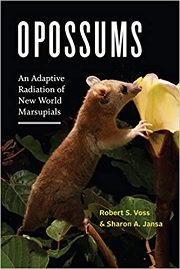Opossums: An Adaptive Radiation of New World Marsupials

Robert S. Voss & Sharon A. Jansa
Johns Hopkins University Press, £44.50 (hardback)
The mention of marsupials immediately conjures images of Australian animals like kangaroos, koalas, wombats and the like. However, as this book explains, marsupials evolved in South America, not Australia. Over 100 species of marsupial can be found, from Canada to the southern tip of the Americas. Of these, opossums, distinct from their relatives the Australian possums, are the most common.
There are no other up-to-date, research-based books about opossums on the market, so this is the current definitive text. It also happens to be very good. The animals themselves are the ‘stars’ with many remarkable features: the water opossum has six digits per hand; some desert opossums have tails that store fat; and several species eat pit vipers and are highly resistant to their venom. Additionally, the short-tailed opossum is a model for biomedical research.
The scientific study of marsupials began when a female opossum from Virginia was dissected in 1698. The authors have been studying opossums for around thirty years and summarise a wide range of research, organised into chapters on phylogenetics, taxonomy, morphology, physiology, behaviour, natural history, population biology and, as per the sub-title, adaptive radiation. They explain what is known very clearly, supported by many citations. They also highlight some of the more mysterious aspects of opossum biology, such as the purpose of the unique sensory organs on the palms and fingers of the six-digited water opossum, and what exactly the evolutionary advantages of ‘playing possum’ (feigning death) are, as the Virginian opossum does. Certainly, there is plenty of scope for future research.
Appendices include a checklist of living opossums as well as lists of fruit and prey eaten by opossums in French Guiana and Brazil, respectively.
‘Opossums’ is very readable and not too daunting for non-specialists. The black and white photos and diagrams are clear and relevant. This book is likely to interest those with research interests in marsupials, primatology, mammalogy, evolutionary biology and anyone just curious about opossums. For researchers of New World marsupials this will be a ‘must’ for the bookshelf.
Dr Sue Howarth CBiol FRSB


